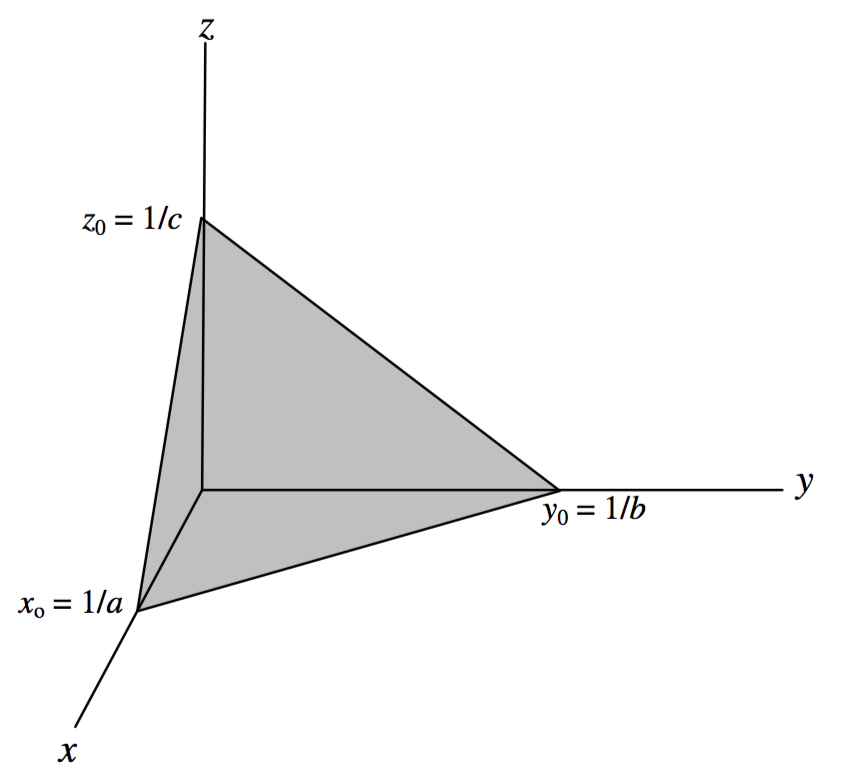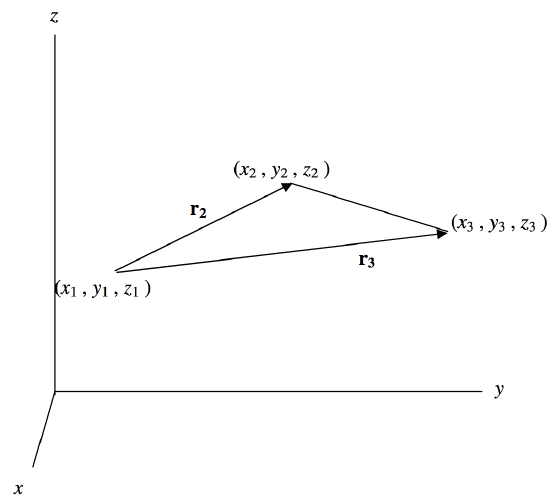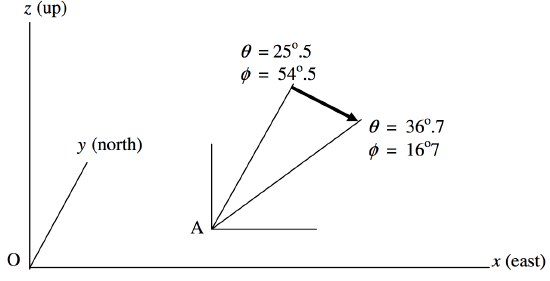4.2: Planes and Straight Lines
( \newcommand{\kernel}{\mathrm{null}\,}\)
The geometry of the plane and the straight line is, of course, rather simple, so that we can dispose of them in this brief introductory section in a mere 57 Equations.
The Equation
Ax+By+Cz+D=0
represents a plane. If D ≠ 0 it is often convenient, and saves algebra and computation with no loss of information, to divide the Equation through by D and re-write it in the form
ax+by+cz=1.
The coefficients need not by any means all be positive. If D=0, the plane passes through the origin of coordinates, and it may be convenient to divide the Equation 4.2.1 by C and hence to rewrite it in the form
ax+by+z=0.
The plane represented by Equation 4.2.2 intersects the yz-, zx- and xy-planes in the straight lines
by+cz=1
cz+ax=1
ax+by=1
and it intersects the x-, y- and z-axes at
x=x0=1/a
y=y0=1/b
z=z0=1/c
The geometry can be seen in figure IV.1

FIGURE IV.1
Another way of writing the Equation to the plane would be
xx0+yy0+zz0=1.
In this form, x0, y0 and z0 are the intercepts on the x-, y- and z-axes.
Distance of a point from the plane
We now consider this problem. Let P1 (x1,y1,z1) be some point in space. What is the perpendicular distance from P1 to the plane ax+by+cz=xx0+yy0+zz0=1?
[The algebra in the following paragraphs may seem a little heavy. If all you are interested in is the distance of the plane from the origin, simply substitute x1=y1=z1=0, and the algebra will be considerably eased.]
Let P(x,y,z) be a point on the plane. The distance s between P1 and P is given by
s2=(x−x1)2+(y−y1)2+(z−z1)2
But since (x,y,z) is on the plane, we can write s2 in terms of x and y alone, by substituting for z from Equation 4.2.2:
s2=(x−x1)2+(y−y1)2+(1−ax−byc−z1)2
This distance (from P to P1) is least for a point on the plane such that ∂s2∂x and ∂s2∂y are both zero. These two conditions result in
(a2+c2)x=a+c2x1−acz1−aby
(b2+c2)y=b+c2y1−bcz1−abx
These, combined with Equation 4.2.2, result in
x=(b2+c2)x1+a(1−by1−cz1)a2+b2+c2
y=(c2+a2)y1+b(1−cz1−ax1)a2+b2+c2
z=(a2+b2)z1+c(1−ax1−by1)a2+b2+c2
These are the coordinates of the point P in the plane that is nearest to P1. The perpendicular distance between P and P1 is
p=1−ax1−by1−cz1√a2+b2+c2
This is positive if P1 is on the same side of the plane as the origin, and negative if it is on the opposite side. If the perpendicular distances of two points from the plane, as calculated from Equation 4.4.18, are of opposite signs, they are on opposite sides of the plane. If p=0, or indeed if the numerator of Equation 4.4.18 is zero, the point P1(x1,y1,z1) is, of course, in the plane.
It is worthwhile to repeat these results for the case where the point P1 coincides with the origin O. In that case we find that the coordinates of the point P on the plane that is nearest to the origin are
x=aa2+b2+c2,y=ba2+b2+c2,z=ca2+b2+c2,
and the perpendicular distance from the origin to the plane (i.e. from O to P) is
p=1√a2+b2+c2
Further, OP is normal to the plane, and the direction cosines (see Chapter 3, especially section 3.3) of OP, i.e. of the normal to the plane, are
a√a2+b2+c2,b√a2+b2+c2,c√a2+b2+c2
The coefficients a, b, c are direction ratios of the normal to the plane; that is to say, they are numbers that are proportional to the direction cosines.
Example: Consider the plane
0.5x+0.25y+0.20z=1
The plane intersects the x-, y- and z-axes at (2,0,0), 0,4,0) and (0,0,5). The point on the plane that is closest to the origin is (1.4184,0.7092,0.5674). The perpendicular distance of the origin from the plane is 1.6843. The direction cosines of the normal to the plane are (0.8422,0.4211,0.3369).
An Equation for the plane containing three specified points can be found as follows. Let (x1,y1), (x2,y2), (x3,y3) be the three specified points, and let (x,y) be any point in the plane that contains these three points. Each of these points must satisfy an Equation of the form 4.2.1. That is,
xA+yB+zC+D=0
x1A+y1B+z1C+D=0
x2A+y2B+z2C+D=0
x3A+y3B+z3C+D=0
In these Equations, we are treating A, B, C, D as unknowns, and the x, y, z, x1, y1... as coefficients. We have four linear Equations in four unknowns, and no constant term. From the theory of Equations, these are consistent only if each is a linear combination of the other three. This is satisfied only if the determinant of the coefficients is zero:
xyz1x1y1z11=0x2y2z21x3y3z31
and this is the Equation to the required plane containing the three points. The reader will notice the similarity of this Equation to Equation 2.2.4 for a line passing between two points in two-dimensional geometry. The reader might like to repeat the argument, but requiring instead the four points to satisfy an Equation of the form 4.2.2. There will then be four linear Equations in three unknowns. Otherwise the argument is the same.
We now move on to the question of finding the area of a triangle whose vertices are given. It is straightforward to do this with a numerical example, and the reader is now encouraged to write a computer program, in whatever language is most familiar, to carry out the following tasks. Read as data the x-y-z coordinates of three points A, B, C. Calculate the lengths of the sides a, b, c, a being opposite to A, etc. Calculate the three angles at the vertices of the triangle, in degrees and minutes, and check for correctness by verifying that their sum is 180∘. If an angle is obtuse, make sure that the computer displays its value as a positive angle between 90∘ and 180∘. Finally, calculate the area of the triangle.
The data for several triangles could be written into a data file, which your program reads, and then writes the answers into an output file. Alternatively, you can type the coordinates of the vertices of one triangle and ask the computer to read the data from the monitor screen, and then to write the answers on the screen followed by a message such as "Do you want to try another triangle (1) or quit (2)?". Your program should also be arranged so that it writes an appropriate message if the three points happen to be collinear.
It should be easy to calculate the sides. The angles can then be calculated from Equation 3.2.2 and the area from each of the four Equations 3.2.3 and 3.2.4. They should all yield the correct answer, of course, but the redundant calculations serve as an important check on the correctness of your programming, as also does your check that the three angles add to 180∘. Where there are two of more ways of performing a calculation, a careful calculator will do all of them as a check against mistakes, whether the calculation is done by hand or by computer.
Example. If the coordinates of the vertices are
A(7,4,3),B(11,6,2),C(9,2,4)
the sides are a=4.899,b=3.000,c=4.583,
and the angles are A=65∘55′,B=36∘42′,C=77∘23′,
which add up to 180∘. The area is 6.708.
Example. If the coordinates of the vertices are
A(6,4,9),B(2,6,17),C(8,3,5)
the area of the triangle is zero and the points are collinear.
The foregoing showed that it was not difficult to calculate numerically the area of the triangle from the coordinates of its vertices. Is it easy to find a simple explicit algebraic formula for the area in terms of (x1,y1,z1), (x2,y2,z2) and (x3,y3,z3)? On referring to figure IV.2, we can proceed as follows.

FIGURE IV.2
The vectors r2 and r3 can be written
r2=(x2−x1)i+(y2−y1)j+(z2−z1)k
r3=(x3−x1)i+(y3−y1)j+(z3−z1)k
where i, j, k are unit vectors parallel to the x-, y- and z- axes.
The cross product of r2 and r3 gives the (vector) area of the parallelogram of which they form two sides. The area A of the triangle is half of this, so that
2A=r2×r3
=[(y2−y1)(z3−z1)−(y3−y1)(z2−z1)]i
+[(z2−z1)(x3−x1)−(z3−z1)(x2−x1)]j
+[(x2−x1)(y3−y1)−(x3−x1)(y2−y1)]k
The magnitude of this vector can be found in the usual way, to obtain
4A2=[(y1(z2−z3)+y2(z3−z1)+y3(z1−z2)]2
+[(z1(x2−x3)+z2(x3−x1)+z3(x1−x2)]2
+[(x1(y2−y3)+x2(y3−y1)+x3(y1−y2)]2.
The reader can verify that, if z1=z2=z3, this reduces to Equation 2.2.12 for the area of a triangle the xy-plane. Equation 4.1.32 can also be written
4A2=|y1y2y3z1z2z3111|2+|z1z2z3x1x2x3111|2+|x1x2x3y1y2y3111|2
This gives the area explicitly in terms of the coordinates of the vertices. If it is zero, the points are collinear.
The volume of a tetrahedron is 16×base×height. By combining Equation 4.2.33 for the area of a triangle with Equation 4.2.14 for the perpendicular distance of a point from a plane, we can determine that the volume of the tetrahedron whose vertices are
(x0,y0,z0), (x1,y1,z1), (x2,y2,z2), (x3,y3,z3)
is 16|x0y0z01x1y1z11x2y2z21x3y3z31|
If this determinant is zero, the four points are coplanar.
In three-dimensional coordinate geometry, a straight line is described by two Equations, being the intersection of two planes:
a1x+b1y+c1z=1
a2x+b2y+c2z=1
If a1/a2=b1/b2=c1/c2,the normals to the two planes have the same direction ratios, so the planes are parallel and do not intersect. Otherwise the normals to the two planes have different direction ratios (a1,b1,c1), (a2,b2,c2), and, since the line of intersection of the planes is at right angles to both normals, the direction ratios of the line are found from the cross product of vectors normal to the planes. The direction ratios of the line of intersection are therefore
(b1c2−b2c1, c1a2−c2a1, a1b2−a2b1)
The line crosses the yz-, zx- and xy- planes at
y=c2−c1b1c2−b2c1z=b1−b2b1c2−b2c1
z=a2−a1c1a2−c2a1x=c1−c2c1a2−c2a1
x=b2−b1a1b2−a2b1y=a1−a2a1b2−a2b1
An example of computing a straight line from the intersection of two planes occurs in meteor astronomy. We can assume a flat Earth, which is tantamount to supposing that the height of a meteor is negligible compared with the radius of Earth, and the height of an observer above sea level is negligible compared with the height of the meteor. Since the heights of meteors are typically a few tens of km, both of these approximations are reasonable, at least for noninstrumental eyewitness accounts.
We suppose that, relative to an arbitrary origin O on the surface of Earth, a witness A is 15 km east and 5 km north of the origin. He sees a fireball start at an angle θ=25∘.5 from his zenith and at an azimuth ϕ=54∘.5 counterclockwise from his east, and it finishes at θ=36∘.7, ϕ=16∘.7. (See figure IV.3.)
Show that the plane containing the witness and the meteor is
0.0363x+0.0911y−0.0454z=1
A second witness, 30 km east and 15 km north of O, estimates the zenith distance and azimuth of two points on the meteor track to be θ=29∘.6, ϕ=202∘.9 and θ=33∘.6, ϕ=242∘.9
Show that the plane containing this second witness and the meteor is
0.0257x+0.0153y+0.0168z=1
These two Equations describe the path of the fireball through the air. Show that, if the meteoroid carries on moving in a straight line, it will strike the ground as a meteorite 42.4 km east and 6.0 km south of the origin O.

FIGURE IV.3
As we have just discussed, two nonparallel planes intersect in a straight line. Usually, three nonparallel planes intersect at a single unique point; for, if L is a line formed from the intersection of planes P1 and P2, L will usually intersect the plane P3 at a point.
Example: The planes
2x+3y+4z−9=0
x+y−8z+6=0
5x+6y−12z+1=0
intersect at (1,1,1).
It will be recalled from the theory of linear Equations that three Equations
A1x+B1y+C1z+D1=0
A2x+B2y+C2z+D2=0
A3x+B3y+C3z+D3=0
have a unique solution only if
Δ=|A1B1C1A2B2C2A3B2C3|≠0
and, in the geometrical interpretation, this is the condition that three planes meet in a single point. Consider, however, the three planes
2x+3y+4z−9=0
x+y−8z+6=0
5x+6y−20z+12=0
The direction ratios of the three lines found by combining the planes in pairs (see Equation 4.2.37) are
(−28,20,−1)(−84,60,−3)(28,−20,1)
It will be observed that each is a multiple of either of the others, and the direction cosines of each of the three lines are identical apart from sign: (∓0.813,±0.581,∓0.029).
The three lines are, in fact, parallel, and the three planes enclose a prism. A condition for this is that
Δ=0.
But consider now the planes
2x+3y+4z−9=0
x+y−8z+6=0
5x+6y−20z+9=0
Not only does Δ=0, but also
Δ′=|A1B1D1A2B2D2A3B3D3|=0
The three lines obtained by combining Equations 4.2.54,55,56 in pairs are in fact identical, and the three planes meet in a single line. Each of Equations 4.2.54,55,56 is a linear combination of the other two.
In summary, three nonparallel planes meet in a single line if ∆ \neq 0. They meet in a single point if ∆ = ∆^\prime = 0. They enclose a prism if ∆ = 0, ∆^\prime \neq 0.


